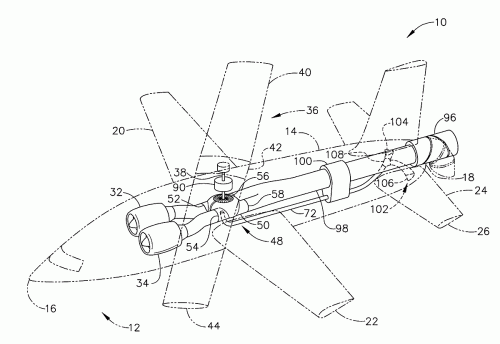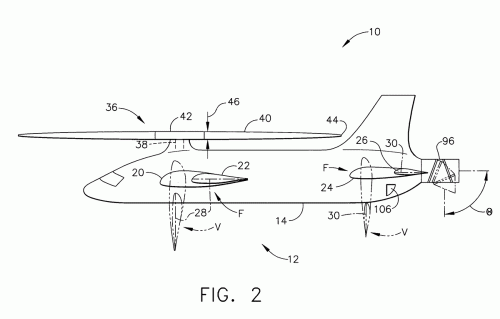Sorry to drag up such an old post, but I just became aware of it, and since I was one of the 2 inventors named in the patent, I thought I'd provide some background. I worked on the Canard Rotor Wing program in St Louis, while my co-inventor Rick Walliser was in our Mesa CRW group. The original CRW as embodied in the X-50A Dragonfly demonstrators was built around a tip-blowing rotor system; engine exhaust gas was ducted up the rotor mast and out to the rotor tips, producing the push to spin the rotor. The idea was that this would avoid the need for a heavy antitorque system, which is an absolute requirement for single-rotor shaft-driven helicopters. But the propulsion system losses were exceptionally high with tip-blowing, well over 50%, and so everything we sized up for any kind of missions always ended up needing much larger engines than conventional rotorcraft to lift the same payload. Bigger engines used more fuel, which meant up-sizing the airframe to hold bigger tanks, which increased the weight which required bigger rotors which needed still bigger engines, etc. And so our CRW machines were always far larger and heavier and more expensive than conventional rotorcraft, when sized for comparable mission performance.
It seemed obvious that switching to a shaft-driven rotor would bring higher efficiencies and let us make more competitive CRW configurations, but there was very strong resistance to doing that, possibly because the basic CRW patents were all framed around tip-blowing. Nevertheless, I put together an Invention Disclosure to not only switch to a shaft-driven rotor, but to also take advantage of any excess gas flow through the engine by adding a rotating aft nozzle. For cruise flight it would point aft, but for hovering it would rotate down, just like a Harrier's 4 nozzles do, to augment the rotor's lift and thereby allow the rotor to be made smaller (lighter, cheaper.) At the same time, Rick out in Mesa had come up with a different approach to channeling the engine's hot gas to drive the rotor, via what he called a Radial Inflow Turbine, basically converting the original CRW hot gas ducting system into something that mechanically drove the rotor, avoiding the need to port hot gas between a fixed center shaft and the rotating blades, which was accounting for quite a bit of the overall system efficiency problem. He submitted his own Invention Disclosure on that. The Company, in its infinite wisdom, decided that since both of our Disclosures were for the same basic type of aircraft (CRW), they could save some money and combine our totally unrelated ideas into a single disclosure rather than submitting patent applications on each one separately. Of course the resulting configuration made no sense at all, but our arguments went unheeded, and eventually there were a series of patents that came out of subsequent attempts to clarify that original mishmash of concepts. I myself ended up with 3 and I believe Rick had even more.
So that's the backstory on this rather weird patent. Anyone who's interested can look up the others and see how muddled the whole story became as derivative patents were scabbed onto the original one. The moral: By trying to save the cost of filing 2 patents and filing just 1, the Company eventually had to pay for around half a dozen more to try and sort out the mess - a good lesson for companies in general!


